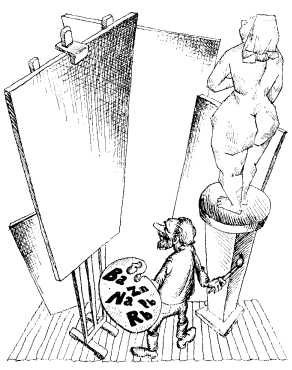107Stories About ChemistryINDEX |
26.
The World of Metals
and Its Paradoxes Over eighty of the elements in the Periodic System are metals. On the whole, they resemble one another more than the nonmetals. And yet there is no end of surprises in the metal kingdom.  For instance, what colour are the different metals? Metallurgists divide all metals into ferrous and nonferrous. The ferrous metals include iron and its alloys. All the rest are nonferrous metals, except for the noble ones, their �Majesties� Silver, Gold and Platinum and Co. This is a very crude division and even the metals themselves object strongly to such lack of discrimination. Each metal actually has its own particular hue. Its dark, dull, or silvery base always has a definite tint. Scientists have become convinced of this by studying metals in the very pure state. Many of them when left in the air, become coated sooner or later with a very thin film of oxide which masks their true colour. But the pure metals give a very wide range of colours. The observant eye can discern metals with bluish, greenish-blue and greenish shades, with a reddish or yellowish play of colours, dark-grey like sea water on a cloudy autumn day, and shiny silvery ones which reflect solar rays like a mirror. The colour of a metal depends on many factors. Among others, it depends upon the method of its production. A metal obtained by sintering has a different appearance from the same metal poured into an ingot. If we compare metals by weight, we can distinguish light, medium and heavy ones. These �weight classes� have their record holders. Lithium, sodium, and potassium do not sink in water, because they are lighter than water. For example, the density of lithium is almost half that of water, which equals unity. Were lithium not so active an element, it would be an excellent material for a great variety of purposes. Imagine a ship or an automobile made entirely of lithium. Unfortunately, chemistry bans this attractive idea. The �heavyweight champion� among the metals is osmium. One cubic centimetre of this noble metal weighs 22.6 grams. To balance one cube of osmium we would have to put on the other tray, say, three cubes of copper, two cubes of lead or four cubes of yttrium. The �performance� of osmium�s closest neighbours, namely, platinum and iridium, is almost as high. The noble metals are also the heaviest metals. The hardness of metals has become proverbial. If a man is always composed and cool-headed, we say he has �iron nerves.� But in the world of metals the situation is different. Here iron is hardly a model of hardness. The hardness champion is chromium which is just slightly inferior to diamond. By the way, paradoxical though it sounds, the hardest chemical elements are not metals at all. At the top of the conventional hardness scale stand diamond (a form of carbon) and crystalline boron. Iron should rather be classed as a soft metal; it is only half as hard as chromium. And as to the lightweights, the alkali metals, they are as soft as wax. |





